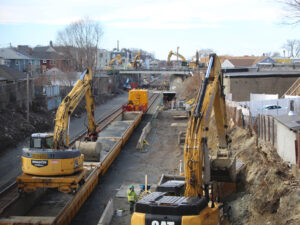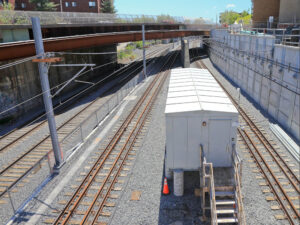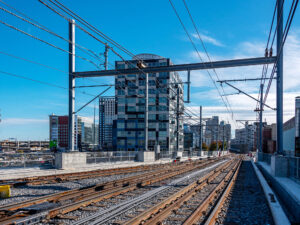Almost five years to the day of receiving Notice to Proceed to start design, the Herzog project team completed the $1B Green Line Extension (GLX) design-build project when the line’s extension to Medford, MA opened on December 12, 2022.
By: William Gilbert
The extension of the Green Line from Lechmere to Medford has been talked about for nearly a century but it was in the early 2000s when the project received funding and planning started in earnest. In the end, it was an exceptional and resilient Herzog project team that got the job done and built this critical public transit asset which is expected to support increased ridership of 50,000+ passenger trips per day to and from Boston.
Herzog, as a part of the Green Line Extension Constructors (GLXC) four-way joint venture with Fluor, Balfour Beatty, and Middlesex, and lead designer STV, was awarded the design-build contract in 2017 after a competitive two-step procurement process.
GLXC, STV, and the owner Massachusetts Bay Transportation Authority (MBTA) started design work in December 2017. The project’s first one-mile branch line from Lechmere into Union Station Square opened to the public on March 21, 2022, followed by the opening of the 3.7-mile branch line from Lechmere to Medford on December 12, 2022.
 Union Square Branch Grand Opening.
Union Square Branch Grand Opening.
A project with it all
The project extends the existing Green Line light rail alignment by 4.7 miles along two operating branches with both branches beginning at the relocated Lechmere Station in Cambridge, MA. The Medford branch extends 3.7 miles north to College Avenue in Medford and the Union Square branch extends one mile west to Union Square in Somerville. The original Lechmere station was demolished and rebuilt as an aerial station, and six new stations with headhouses and level boarding platforms were constructed along the two branches.
 GLX Branch Lines – Lechmere to Union Square and Lechmere to Medford/Tufts
GLX Branch Lines – Lechmere to Union Square and Lechmere to Medford/Tufts
A new 55,000 square foot four-bay Vehicle Maintenance Facility (VMF) and rail yard for light rail vehicles and a 1,509 square-foot Transportation Building used as the GLX control center were also designed and constructed. The entirety of the project was constructed in the MBTA commuter rail right-of-way. Live track work was coordinated around 56 daily MBTA, Amtrak, and Pan Am Railways trains. The project had it all – scopes of work included ballasted track, at-grade and aerial stations, a VMF, a bike path, seven different types of retaining walls plus sound walls, vehicular and rail bridges, viaduct structures, and new signal and Overhead Catenary Systems (OCS), and integration into one of the oldest light rail systems in the U.S. Added to the mix was live trackwork coordination, construction in a dense urban environment, and navigation of the evolving safety and health requirements and industry supply chain challenges brought on by the COVID 19 pandemic.
“I am incredibly proud of the GLXC team in all they accomplished,” shared Craig Ebersold, GLXC Project Manager and Herzog Vice President of Project Execution – National Construction. “The design and construction solutions this team produced to tackle the project’s highly complex challenges were impressive. A high degree of collaboration across all levels of the project organization was fundamental to our project success.”
 GLX viaduct structures and the pedestrian bridge (on the right) rise above the MBTA Boston Engine Terminal railyard with Boston in the background.
GLX viaduct structures and the pedestrian bridge (on the right) rise above the MBTA Boston Engine Terminal railyard with Boston in the background.
Overcoming access challenges with Herzog equipment
The project’s location presented many challenges ranging from right-of-way access, logistics, soil contamination, and working in an active railroad environment. The new GLX guideway was constructed in a narrow, active rail corridor that is over a hundred years old, and the rail corridor ran in a depressed trench-like guideway surrounded by dense neighborhoods. The project team was literally building on top of a city with work occurring only a few feet from homes and businesses.
 Herzog’s MPM working in the MBTA right-of-way
Herzog’s MPM working in the MBTA right-of-way
The Herzog project team used its Multi-Purpose Machine (MPM) – a rail-running, compact work platform with a zero-turn radius track hoe and low-profile gondola cars – to overcome many of these project access and logistics challenges where it was virtually impossible for heavy equipment to access the right-of-way. “The use of the MPM was ideally suited to overcome the project’s significant constraints. We were fortunate to have this specialized piece of Herzog equipment supporting our construction work,” said Craig. When it came time to trench 2,227 feet in the right-of-way for a 60-inch Fiberglass Reinforced Polymer (FRP) drainpipe, there was no room for heavy excavation equipment and dump trucks to safely maneuver adjacent to the live tracks. To maximize production and safely work within this right-of-way, the MPM was brought in. The MPM occupied one of the two existing tracks to deliver pipe and shoring materials, performed trench excavation, and hauled the excavated materials out of the right-of-way all the while MBTA commuter trains passed within feet of the MPM and the trenching operations.
 The MPM placing FRP drainage.
The MPM placing FRP drainage.
Building in an active rail corridor
One of the biggest project challenges was figuring out how to construct GLX safely and efficiently within the existing double track MBTA right-of-way while maintaining commuter rail operations. A new four-track configuration was needed so that GLX light rail and commuter trains could run side-by-side within the corridor.
 An MBTA Commuter Train passes by foundation work for the future GLX Ball Square Station.
An MBTA Commuter Train passes by foundation work for the future GLX Ball Square Station.
The Herzog team worked extensively with MBTA during pre-construction to devise a three-step phasing and sequencing work plan to allow commuter rail operations to continue during construction. The logistical, safety, and stakeholder coordination complexities of building the GLX tracks were enormous. Herzog crews widened the existing track bed along much of the alignment north of Lechmere Station. This required major excavation within the right-of-way and shifting the two commuter rail tracks to create the needed track bed space to add the two new GLX tracks. First, the embankment on the west side of the right-of-way was excavated back with commuter trains continuing to operate in the right-of-way. Once excavation was complete, two interim tracks were constructed within the newly excavated space, and during scheduled weekend service shutdowns, the commuter trains were shifted from the east to the west side of the right-of-way onto the interim tracks. Crews then entered the east side of the right-of-way, demolished the original commuter rail tracks, excavated back the embankment, built retaining and sound walls, installed new track underdrains, prepared a new, wider track bed, constructed two commuter rail tracks in their final position, and commuter train service was shifted back onto these new tracks. In all, crews completed 12 track shifts for a total of 10,500 track feet. For the third and final phase, crews entered the west side of the right-of-way, demolished the now out-of-service interim commuter rail tracks, and completed GLX track work and associated drainage and retaining wall infrastructure. By the end of the project, 362,400 cubic yards of earth was excavated from the right-of-way and 260,000+ square feet of retaining wall had been erected to retain the cut into the slope’s embankment.
 The completed alignment at Medford St. Bridge looking south. GLX tracks are on the ight and MBTA commuter rail tracks are on the left.
The completed alignment at Medford St. Bridge looking south. GLX tracks are on the ight and MBTA commuter rail tracks are on the left.
Power of the Team – Getting the job done
During peak construction, approximately 650 management and field staff were mobilized. The project team had on average 500 field personnel working daily within the Union Square and Medford branches with 300 pieces of equipment in operation. The project was supported by 150 GLXC office staff and field supervision working out of various project offices.By the end of the project in December 2022, the Herzog project team had logged 5.3+ million hours. The Herzog project team navigated numerous challenges and complexities to deliver this billion-dollar design-build project. It was a collective and relentless effort on everyone’s part – a true demonstration and embodiment of the Power of the Team. We want to take a moment and recognize those at Herzog and our partners who worked on the project, their remarkable work, and their commitment to getting the job done. You are the team that delivered a project that has been a century in the making.

